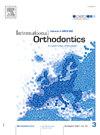正畸复合粘接剂剪切粘结强度、粘接剂残留指数和转化程度的评价:一项使用人前磨牙的体外研究
IF 1.9
Q2 DENTISTRY, ORAL SURGERY & MEDICINE
引用次数: 0
摘要
目的比较4种不同正畸粘接剂的剪切粘结强度(SBS)、粘接剂残留指数(ARI)和转化度(DC)。材料与方法60颗上颌第一前磨牙根据使用的黏合剂类型随机分为4组(n = 15):ⅰ组Grengloo™(GG),ⅱ组Trulock®(TL),ⅲ组CuRAY-Eclipse®(EC),ⅳ组Master-Dent®(MD)。SBS用通用试验机测试,ARI评分用体视显微镜评估。为评估DC,每组各制备5个固化标本和5个未固化标本。采用傅里叶变换红外光谱仪(FTIR)对各复合材料的直流电进行了评价。SBS数据分析采用Welch单因素方差分析,随后采用Games-Howell事后检验。ARI指数得分通过Kruskal-Wallis测试进行分析,随后进行Dunn事后测试。直流数据分析采用单因素方差分析检验,其次是Tukey事后检验。所有检验的显著性水平均为P <; 0.05。结果两组患者平均SBS差异有统计学意义(P < 0.001) (PES: 0.684, 95% CI[0.460 ~ 0.757])。GG黏合剂的平均SBS(19.63±4.44 MPa)高于其他黏合剂。EC的平均SBS(14.15±5.28 MPa)明显高于MD(9.98±1.81 MPa)。TL与EC的平均SBS(11.96±3.34 MPa)、TL与MD的平均SBS无显著差异。两种粘接剂的ARI评分差异有显著性(P < 0.001) (PES[H]: 0.262, 95% CI[0.100 ~ 0.510])。GG、TL和EC的粘结破坏主要是内聚破坏,而MD的粘结破坏主要发生在牙釉质/粘接剂界面。被测复合材料之间的DC值有显著差异(P = 0.010) (PES: 0.518, 95% CI[0.202 ~ 0.640])。GG(83.66±2.48%)的平均DC明显高于MD(74.57±5.47%)。GG、TL(77.02±2.42%)与EC(78.36±3.23%)、TL、EC与md(78.36±3.23%)之间的DC平均值差异无统计学意义。结论GG的SBS最高。所有测试的粘接剂显示出足够和可接受的SBS和DC用于临床实践。除MD在牙釉质/黏合剂界面处表现出黏合破坏外,其余均表现出黏合破坏。DC受复合类型的影响。GG的DC最高,显著高于MD。本文章由计算机程序翻译,如有差异,请以英文原文为准。
Evaluation of shear bond strength, adhesive remnant index, and degree of conversion of orthodontic composite adhesives: An in vitro study using human premolars
Objective
This study aimed to compare the shear bond strength (SBS), adhesive remnant index (ARI), and degree of conversion (DC) of four different orthodontic adhesives.
Material and methods
Sixty maxillary first premolars were randomly divided into four groups (n = 15) according to the type of adhesive used: group I, Grengloo™ (GG), group II, Trulock® (TL), group III, CuRAY-Eclipse® (EC), and group IV, Master-Dent® (MD). The SBS was tested using a universal testing machine, and the ARI scores were evaluated by using a stereomicroscope. For assessing the DC, 5 cured and 5 uncured specimens were prepared for each group. FTIR (Fourier Transform Infrared) spectrometer was used to evaluate the DC for each composite. The SBS data were analysed by the Welch one-way ANOVA test, followed by Games-Howell post hoc test. ARI index scores were analysed by the Kruskal-Wallis test, followed by Dunn's post hoc test. The DC data were analysed by using the one-way ANOVA test, followed by Tukey's post hoc test. The significance level was set at P < 0.05 within all tests.
Results
There was a significant difference in the mean SBS (P < 0.001) between the tested groups (PES: 0.684, 95% CI [0.460 to 0.757]). GG had a statistically significantly higher mean SBS (19.63 ± 4.44 MPa) than the other adhesives. EC had a significantly higher mean SBS (14.15 ± 5.28 MPa) than MD (9.98 ± 1.81 MPa). There was no significant difference in mean SBS between TL (11.96 ± 3.34 MPa) and EC or between TL and MD. There was a significant difference in ARI scores (P < 0.001) between the tested adhesives (PES[H]: 0.262, 95% CI [0.100 to 0.510]). The predominant mode of bond failure in GG, TL, and EC was cohesive failure, while MD revealed bond failure at the enamel/adhesive interface. There was a significant difference (P = 0.010) in the DC values between the tested composites (PES: 0.518, 95% CI [0.202 to 0.640]). GG (83.66 ± 2.48%) had a significantly higher mean DC than MD (74.57 ± 5.47%). There was no significant difference in the mean values of the DC between GG, TL (77.02 ± 2.42%), and EC (78.36 ± 3.23%), or between TL, EC, and MD.
Conclusion
GG had the highest SBS. All the tested adhesives showed adequate and acceptable SBS and DC for clinical practice. All the adhesives revealed cohesive bond failure, except MD exhibited bond failure at the enamel/adhesive interface. The DC was influenced by the composite type. GG had the highest DC and was significantly higher than MD.
求助全文
通过发布文献求助,成功后即可免费获取论文全文。
去求助
来源期刊

International Orthodontics
DENTISTRY, ORAL SURGERY & MEDICINE-
CiteScore
2.50
自引率
13.30%
发文量
71
审稿时长
26 days
期刊介绍:
Une revue de référence dans le domaine de orthodontie et des disciplines frontières Your reference in dentofacial orthopedics International Orthodontics adresse aux orthodontistes, aux dentistes, aux stomatologistes, aux chirurgiens maxillo-faciaux et aux plasticiens de la face, ainsi quà leurs assistant(e)s. International Orthodontics is addressed to orthodontists, dentists, stomatologists, maxillofacial surgeons and facial plastic surgeons, as well as their assistants.
 求助内容:
求助内容: 应助结果提醒方式:
应助结果提醒方式:


